6. Virtual Private Routed Network Service
This chapter provides information about the Virtual Private Routed Network (VPN) service and implementation notes. VPRN services are supported only in network mode.
6.1. VPRN Service Overview
RFC2547b is an extension to the original RFC 2547, which details a method of distributing routing information and forwarding data to provide a Layer 3 Virtual Private Network (VPN) service to end customers.
Each Virtual Private Routed Network (VPRN) consists of a set of customer sites connected to one or more PE routers. Each associated PE router maintains a separate IP forwarding table for each VPRN. Additionally, the PE routers exchange the routing information configured or learned from all customer sites via MP-BGP peering. Each route exchanged via the MP-BGP protocol includes a Route Distinguisher (RD), which identifies the VPRN association.
The service provider uses BGP to exchange the routes of a particular VPN among the PE routers that are attached to that VPN. This is done in a way which ensures that routes from different VPNs remain distinct and separate, even if two VPNs have an overlapping address space. The PE routers distribute routes from other CE routers in that VPN to the CE routers in a particular VPN. Since the CE routers do not peer with each other there is no overlay visible to the VPN routing algorithm.
When BGP distributes a VPN route, it also distributes an MPLS label for that route. On a SR-Series, the label distributed with a VPN route depends on the configured label-mode of the VPRN that is originating the route.
Before a customer data packet travels across the service provider's backbone, it is encapsulated with the MPLS label that corresponds, in the customer's VPN, to the route which best matches the packet's destination address. The MPLS packet is further encapsulated with either another MPLS label header, so that it gets tunneled across the backbone to the correct PE router. Each route exchanged by the MP-BGP protocol includes a route distinguisher (RD), which identifies the VPRN association. Therefore the backbone core routers do not need to know the VPN routes. Figure 53 shows a VPRN network diagram example.
Figure 53: Virtual Private Routed Network
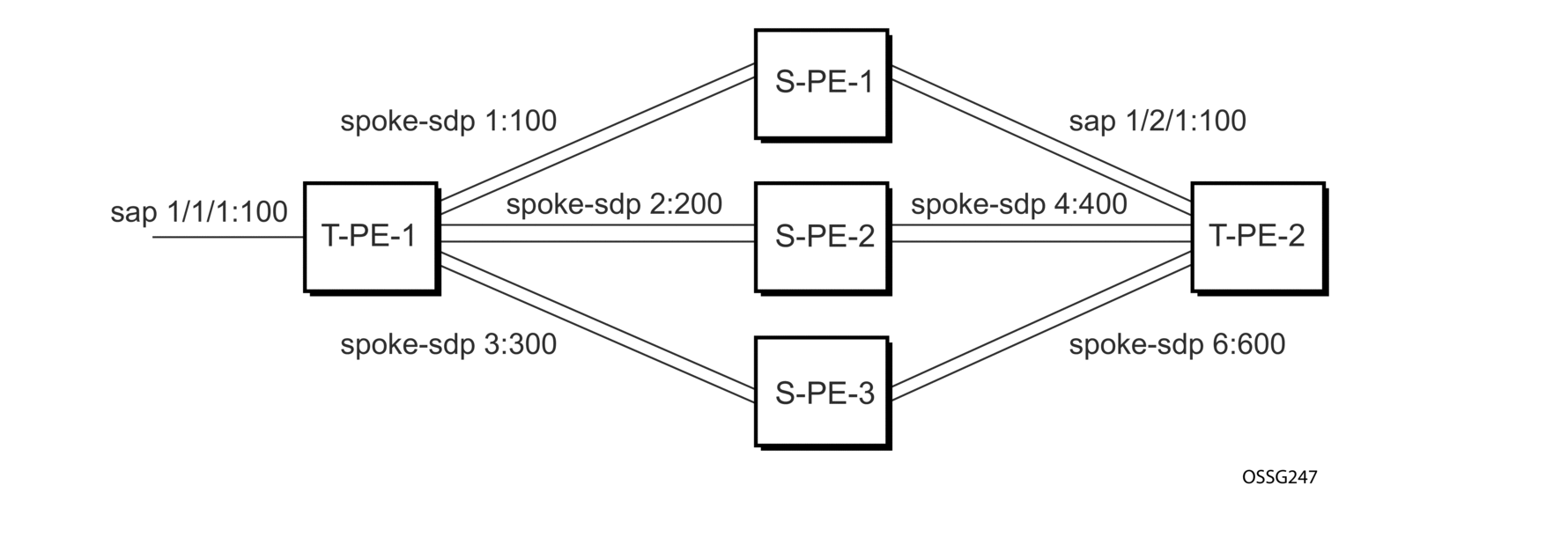
6.1.1. Routing Prerequisites
RFC2547bis requires the following features:
- Multi-protocol extensions
- Extended BGP community support
- BGP capability negotiation
- Parameters defined in RFC 2918
Tunneling protocol options are as follows:
- Label Distribution Protocol (LDP)
- MPLS RSVP-TE tunnels
6.1.2. BGP Support
BGP is used with BGP extensions mentioned in Routing Prerequisites to distribute VPRN routing information across the service provider network.
BGP was initially designed to distribute IPv4 routing information. Therefore, multi-protocol extensions and the use of a VPN-IPv4 address were created to extend ability of the BGP to carry overlapping routing information. A VPN-IPv4 address is a 12-byte value consisting of the 8-byte route distinguisher (RD) and the 4-byte IPv4 IP address prefix. The RD must be unique within the scope of the VPRN. This allows the IP address prefixes within different VRFs to overlap.
A VPN-IPv6 address is a 24-byte value consisting of the 8-byte RD and 16-byte IPv6 address prefix. Service providers typically assign one or a small number of RDs per VPN service network-wide.
6.1.3. Route Distinguishers
The route distinguisher (RD) is an 8-byte value consisting of 2 major fields, the Type field and Value field, as shown in Figure 54. The Type field determines how the Value field should be interpreted. The 7210 SAS implementation supports the three (3) Type values as defined in the Internet draft.
Figure 54: Route Distinguisher

The three Type values are:
- Type 0: Value Field — Administrator subfield (2 bytes) Assigned number subfield (4 bytes)The administrator field must contain an ASN (using private AS numbers is discouraged). The Assigned field contains a number assigned by the service provider.
- Type 1: Value Field — Administrator subfield (4 bytes) Assigned number subfield (2 bytes)The administrator field must contain an IP address (using private IP address space is discouraged). The Assigned field contains a number assigned by the service provider.
- Type 2: Value Field — Administrator subfield (4 bytes) Assigned number subfield (2 bytes)The administrator field must contain a 4-byte ASN (using private AS numbers is discouraged). The Assigned field contains a number assigned by the service provider.
6.1.3.1. Route Reflector
Per RFC2547bis the use of Route Reflectors is supported in the service provider core. Multiple sets of route reflectors can be used for different types of BGP routes, including IPv4 and VPN-IPv6. 7210 can only be used a route reflector client. It cannot be used as a route reflector ("server").
6.1.3.2. CE to PE Route Exchange
Routing information between the Customer Edge (CE) and Provider Edge (PE) can be exchanged by the following methods:
- Static Routes (with both IPv4 and IPv6)
- E-BGP (with both IPv4 and IPv6 VPNs)
Each protocol provides controls to limit the number of routes learned from each CE router.
6.1.3.2.1. Route Redistribution
Routing information learned from the CE-to-PE routing protocols and configured static routes should be injected in the associated local VPN routing/forwarding (VRF). In the case of dynamic routing protocols, there may be protocol specific route policies that modify or reject certain routes before they are injected into the local VRF.
Route redistribution from the local VRF to CE-to-PE routing protocols is to be controlled via the route policies in each routing protocol instance, in the same manner that is used by the base router instance.
The advertisement or redistribution of routing information from the local VRF to or from the MP-BGP instance is specified per VRF and is controlled by VRF route target associations or by VRF route policies.
VPN-IP routes imported into a VPRN, have the protocol type bgp-vpn to denote that it is an VPRN route. This can be used within the route policy match criteria.
6.1.3.2.2. CPE Connectivity Check
Static routes are used within many IES and VPRN services. Unlike dynamic routing protocols, there is no way to change the state of routes based on availability information for the associated CPE. CPE connectivity check adds flexibility so that unavailable destinations will be removed from the VPRN routing tables dynamically and minimize wasted bandwidth.
Figure 55 and Figure 56 show static routes.
Figure 55: Directly Connected IP Target
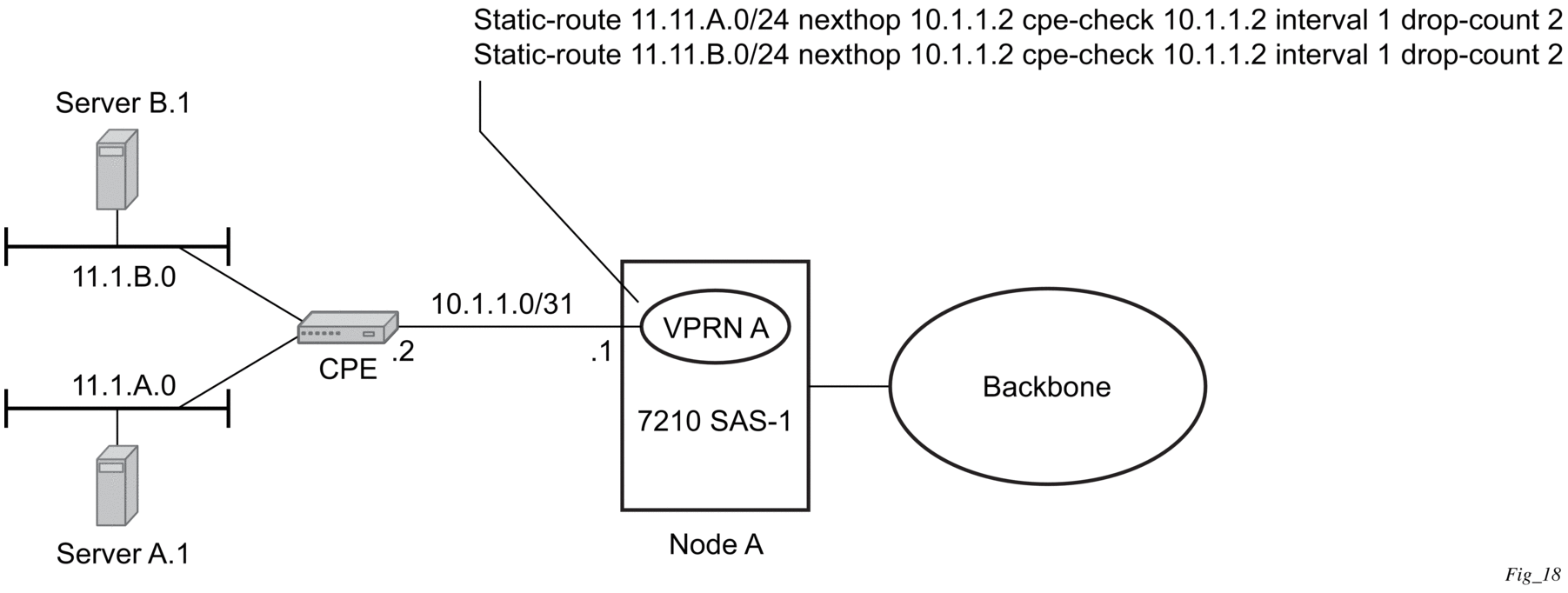
Figure 56: Multiple Hops to IP Target
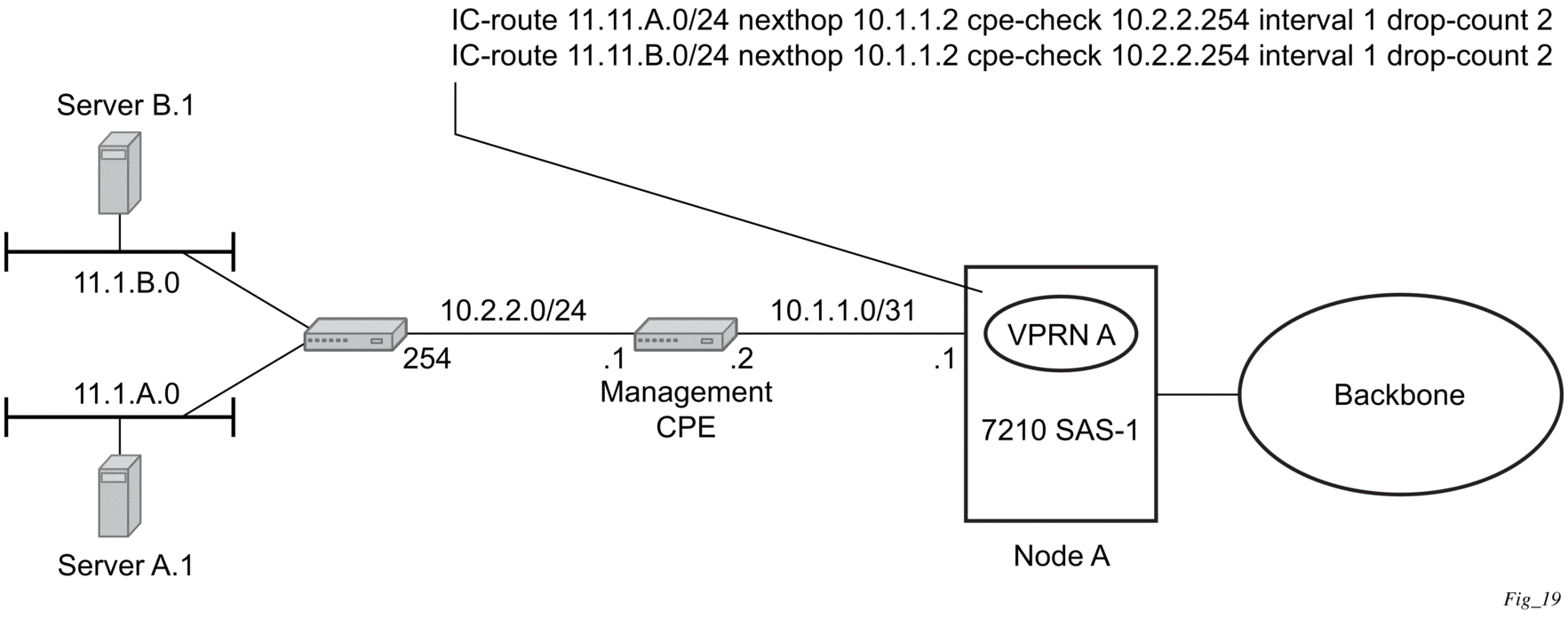
The availability of the far-end static route is monitored through periodic polling. The polling period is configured. If the poll fails a specified number of sequential polls, the static route is marked as inactive.
Either ICMP ping or unicast ARP mechanism can be used to test the connectivity. ICMP ping is preferred.
If the connectivity check fails and the static route is de-activated, the 7210 SAS router will continue to send polls and reactivate any routes that are restored.
6.1.4. BGP Fast Reroute in a VPRN
BGP fast reroute is a feature that brings together indirection techniques in the forwarding plane and precomputation of BGP backup paths in the control plane to support fast reroute of BGP traffic around unreachable/failed next-hops. In a VPRN context BGP fast reroute is supported using VPN-IPv4 and VPN-IPv6 VPN routes. The supported VPRN scenarios are described in Table 84.
Table 84: BGP Fast Reroute Scenarios (VPRN Context)
Ingress Packet | Primary Route | Backup Route | Prefix Independent Convergence |
IPv4 (ingress PE) | VPN-IPv4 route with next-hop A resolved by a LDP, RSVP or BGP tunnel | VPN-IPv4 route with next-hop A resolved by a LDP, RSVP or BGP tunnel | Yes |
IPv6 (ingress PE) | VPN-IPv6 route with next-hop A resolved by a LDP, RSVP or BGP tunnel | VPN-IPv6 route with next-hop B resolved by a LDP, RSVP or BGP tunnel | Yes |
6.1.4.1. BGP Fast Reroute in a VPRN Configuration
Configuring the enable-bgp-vpn-backup command under config>service>vprn causes only imported BGP-VPN routes to be considered when selecting the primary and backup paths.
This command is required to support fast failover of ingress traffic from one remote PE to another remote PE.
| Note: 7210 SAS devices do not support BGP backup path command that is used to enable consideration of multiple paths learned from CE BGP peers when selecting primary and backup path to reach the CE. |
6.2. VPRN Features
This section describes various VPRN features and any special capabilities or considerations as they relate to VPRN services.
6.2.1. IP Interfaces
VPRN customer IP interfaces can be configured with most of the same options found on the core IP interfaces. The advanced configuration options supported are:
- VRRP for IPv4 IP interfaces only
- ICMP Options
Configuration options found on core IP interfaces not supported on VPRN IP interfaces are:
- NTP broadcast receipt
6.2.2. IP Interfaces
VPRN customer IP interfaces can be configured with most of the same options found on the core IP interfaces.
The advanced configuration options supported are:
- VRRP
- Secondary IP addresses
- ICMP Options
Configuration options found on core IP interfaces not supported on VPRN IP interfaces are:
- NTP broadcast receipt
6.2.3. SAPs
This section provides information about SAPs.
6.2.3.1. IPv6 Support for VPRN IP Interfaces (in Network Mode)
VPRN IPv6 access interfaces are allowed to be configured to provide IPv6 VPN connectivity to customers.
IPv4 and IPv6 route table lookup entries are shared. Before adding routes for IPv6 destinations, route entries in the routed lookup table needs to be allocated for IPv6 addresses. This can be done using the config>system>resource-profile>router>max-ipv6-routes command. This command allocates route entries for /64 IPv6 prefix route lookups. The system does not allocate any IPv6 route entries by default and user needs to allocate some resources before using IPv6. For the command to take effect the node must be rebooted after making the change. For more information, refer to the following example and the 7210 SAS-M, T, R6, R12, Mxp, Sx, S Basic System Configuration Guide.
A separate route table (or a block in the route table) is used for IPv6 /128-bit prefix route lookup. A limited amount of IPv6 /128 prefixes route lookup entries is supported. The software enables lookups in this table by default (that is, no user configuration is required to enable IPv6 /128-bit route lookup).
In addition, the number IP subnets can be configured by the user using the configure> system>resource-profile>router>max-ip-subnets command. Suitable default are assigned to this parameter. Users can increase the number of subnets if they plan to more IPv6 addresses per IPv6 interface.
Following features and restrictions is applicable for IPv6 VPRN IP interfaces:
- PE-CE routing - static routing and EBGP is supported.
- A limited amount of IPv6 /128 prefixes route lookup entries is supported on 7210 SAS platforms.
- VRRP for VPRN IPv6 interfaces is not supported.
6.2.3.2. Encapsulations
The following SAP encapsulations are supported on the 7210 SAS VPRN service:
- Ethernet null
- Ethernet dot1q
- QinQ
- LAG
6.2.4. QoS Policies
When applied to a VPRN SAP, service ingress QoS policies only create the unicast queues defined in the policy (as multicast is not supported in VPRN service).
Multicast is not supported in VPRN service.
Both Layer 2 (dot1p only) or Layer 3 criteria can be used in the QoS policies for traffic classification in an VPRN.
6.2.5. Filter Policies
Ingress and egress IPv4 and IPv6 filter policies can be applied to VPRN SAPs.
6.2.5.1. CPU QoS for VPRN Interfaces
Traffic bound to CPU received on VPRN access interfaces are policed/rate-limited and queued into CPU queues. The software allocates a policer per IP application or a set of IP applications, for rate-limiting CPU bound IP traffic from all VPRN access SAPs. The policers CIR/PIR values are set to appropriate values based on feature scaling and these values are not user configurable. The software allocates a set of queues for CPU bound IP traffic from all VPRN access SAPs. The queues are either shared by a set of IP applications or in some cases allocated to an IP application. The queues are shaped to appropriate rate based on feature scaling. The shaper rate is not user-configurable.
Note:
|
6.2.6. CE to PE Routing Protocols
The 7210 SAS VPRN supports the following PE to CE routing protocols:
- eBGP (for both IPv4 and IPv6)
- Static with both IPv4 and IPv6)
- OSPF v2 (IPv4)
6.2.6.1. PE to PE Tunneling Mechanisms
The 7210 SAS supports multiple mechanisms to provide transport tunnels for the forwarding of traffic between PE routers within the 2547bis network.
The 7210 SAS VPRN implementation supports the use of:
- RSVP-TE protocol to create tunnel LSP's between PE routers
- LDP protocol to create tunnel LSP's between PE routers
These transport tunnel mechanisms provide the flexibility of using dynamically created LSPs where the service tunnels are automatically bound (the “autobind” feature) and the ability to provide certain VPN services with their own transport tunnels by explicitly binding SDPs if desired. When the autobind is used, all services traverse the same LSPs and do not allow alternate tunneling mechanisms or the ability to craft sets of LSP's with bandwidth reservations for specific customers as is available with explicit SDPs for the service.
6.2.6.2. Per VRF Route Limiting
The 7210 SAS allows setting the maximum number of routes that can be accepted in the VRF for a VPRN service. There are options to specify a percentage threshold at which to generate an event that the VRF table is near full and an option to disable additional route learning when full or only generate an event.
6.2.7. Exporting MP-BGP VPN Routes
To reduce the number of MP-BGP VPN tunnels in a group of IP/MPLS PE routers that are part of the same L3 VPN instance, a hierarchy can be established by reexporting the VPN IP routes on a PE aggregation router (which can be an ABR node). In the case of VPRN service labels, reexporting VPN IP routes reduces the required MPLS FIB resources to the scale available on smaller access routers.
Use the config>service>vprn>allow-export-bgp-vpn command to configure the feature. This command enables the vrf-export and vrf-target export functions to include BGP-VPN routes that are installed in the VPRN route table.
When a route is installed in the VPRN route table, the route is exported as a new VPN-IP route to an MP-IBGP peer only; that is, the route is accepted by the VRF export policy but may be rejected by a BGP export policy. Assuming that the export policies have simple accept and reject actions, the new VPN-IP route is the same as the original VPN-IP route, except in the following cases.
- The RD is changed to the value of the advertising VPRN.
- The BGP next-hop is changed to a local address of the PE.
- The label value is changed to the per-VRF label value of the advertising VPRN.
6.2.7.1. Configuration Guidelines
The following configuration guidelines apply to this feature.
- You must shut down and restart the VPRN context for any changes to the allow-export-bgp-vpn command to take effect.
- You must configure the VPRN service with a loopback IP interface for the command to take effect.
- SAPs cannot be configured in a VPRN service in which the allow-export-bgp-vpn command is enabled.
6.2.8. Spoke SDPs
Spoke-SDP termination into a Layer 3 service is not supported on 7210 SAS platforms.
Distributed services use service distribution points (SDPs) to direct traffic to another SR-Series router via service tunnels. SDPs are created on each participating SR-Series and then bound to a specific service. SDP can be created as either GRE or MPLS. Refer to SDPs for information about configuring SDPs.
This feature provides the ability to cross-connect traffic entering on a spoke-SDP, used for Layer 2 services (VLLs or VPLS), on to an IES or VPRN service. From a logical point of view, the spoke-SDP entering on a network port is cross-connected to the Layer 3 service as if it entered by a service SAP. The main exception to this is traffic entering the Layer 3 service by a spoke-SDP is handled with network QoS policies not access QoS policies.
Figure 57 shows traffic terminating on a specific IES or VPRN service that is identified by the sdp-id and VC label present in the service packet.
Figure 57: SDP-ID and VC Label Service Identifiers
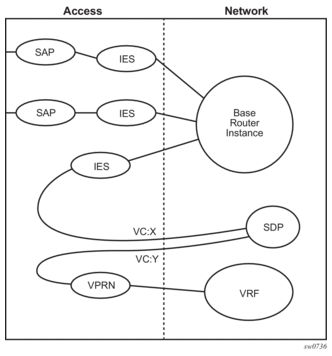
Figure 58 shows a spoke-SDP terminating directly into an IES. In this case, a spoke-SDP could be tied to an Epipe or H-VPLS service. There is no configuration required on the PE connected to the CE.
Figure 58: Spoke-SDP Termination
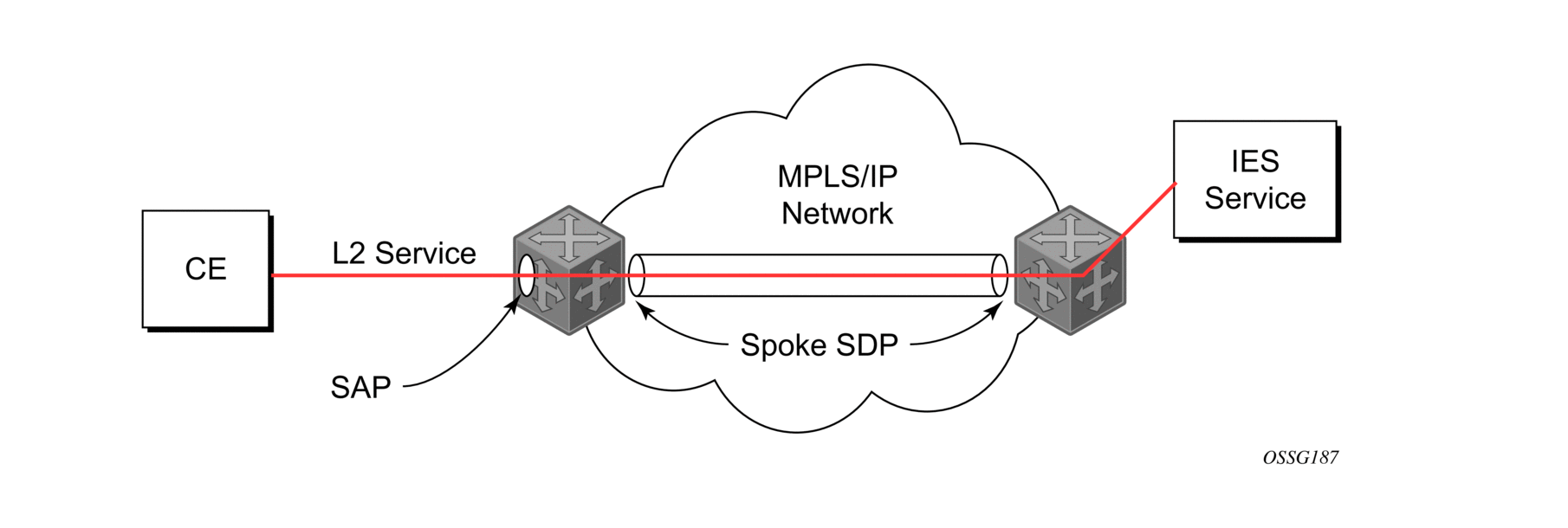
Note that all the routing protocols, including multicast, that are supported by VPRN are supported for spoke-sdp termination.
6.2.8.1. T-LDP Status Signaling for Spoke SDPs Terminating on IES/VPRN
T-LDP status signaling and PW active/standby signaling capabilities are supported on ipipe and epipe spoke SDPs.
Spoke-SDP termination on an IES or VPRN provides the ability to cross-connect traffic entering on a spoke-SDP, used for Layer 2 services (VLLs or VPLS), on to an IES or VPRN service. From a logical point of view the spoke-SDP entering on a network port is cross-connected to the Layer 3 service as if it had entered using a service SAP. The main exception to this is traffic entering the Layer 3 service using a spoke-SDP is handled with network QoS policies instead of access QoS policies.
When a SAP Down or SDP binding down status message is received by the PE in which the ipipe or Ethernet spoke-sdp is terminated on an IES or VPRN interface, the interface is brought down and all associated routes are withdrawn in a similar way when the spoke-sdp goes down locally. The same actions are taken when the standby T-LDP status message is received by the IES/VPRN PE.
This feature can be used to provide redundant connectivity to a VPRN or IES from a PE providing a VLL service, as shown in Figure 59.
Figure 59: Active/Standby VRF Using Resilient L2 Circuits
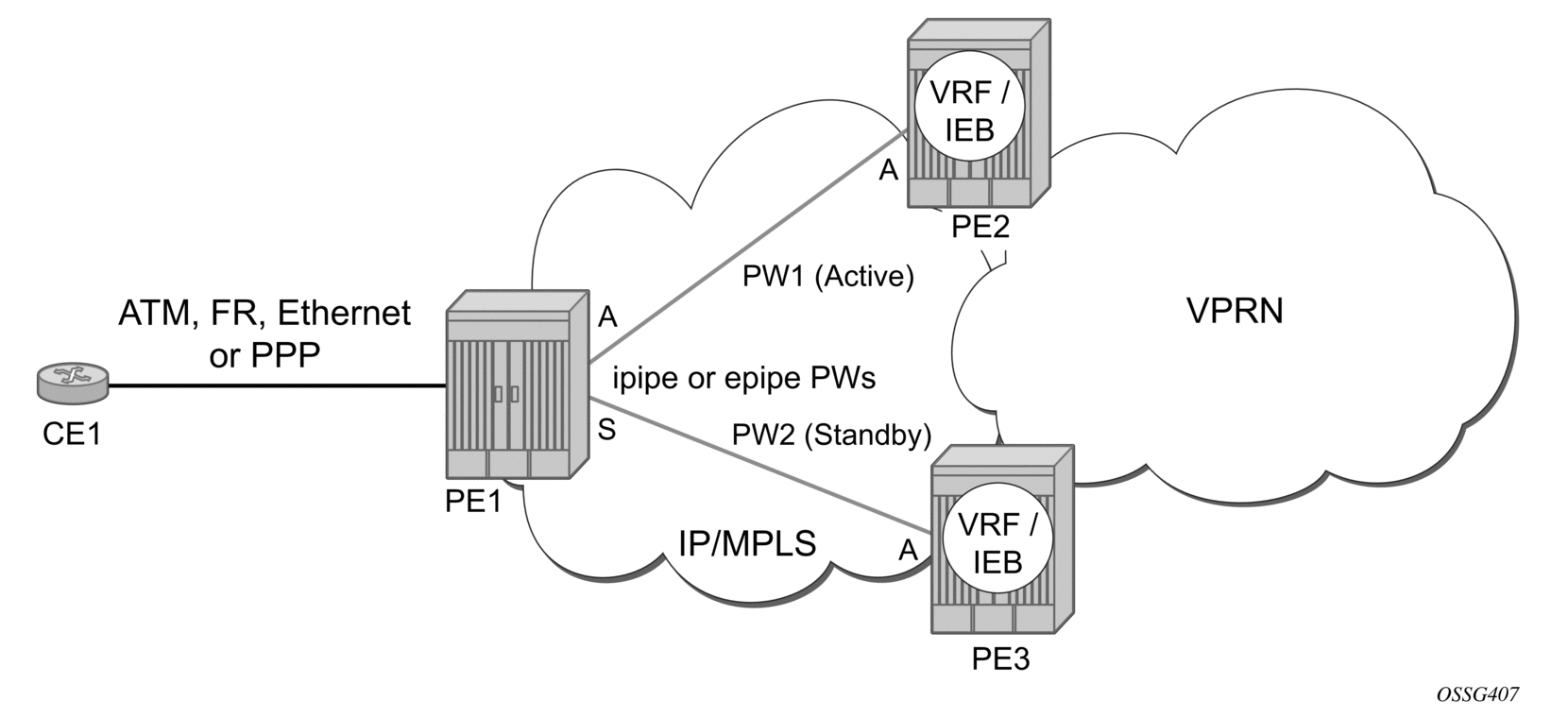
6.2.8.2. GR Helper for CE-PE Routing Protocols
The GR helper function for BGP and OSPF between CE and PE is supported for routing protocols that are running in the default routing context.
6.2.8.3. Spoke-SDP Redundancy into IES/VPRN
This feature can be used to provide redundant connectivity to a VPRN or IES from a PE providing a VLL service, as shown in Figure 59, using either epipe or ipipe spoke-SDPs.
In Figure 59, PE1 terminates two spoke-SDPs that are bound to one SAP connected to CE1. PE1 chooses to forward traffic on one of the spoke SDPs (the active spoke-SDP), while blocking traffic on the other spoke-SDP (the standby spoke-SDP) in the transmit direction. PE2 and PE3 take any spoke-SDPs for which PW forwarding standby has been signaled by PE1 to an operationally down state.
Note that 7210 routers are expected to fulfill both functions (VLL and VPRN/IES PE). Figure 60 shows the model for spoke-SDP redundancy into a VPRN or IES.
Figure 60: Spoke-SDP Redundancy Model
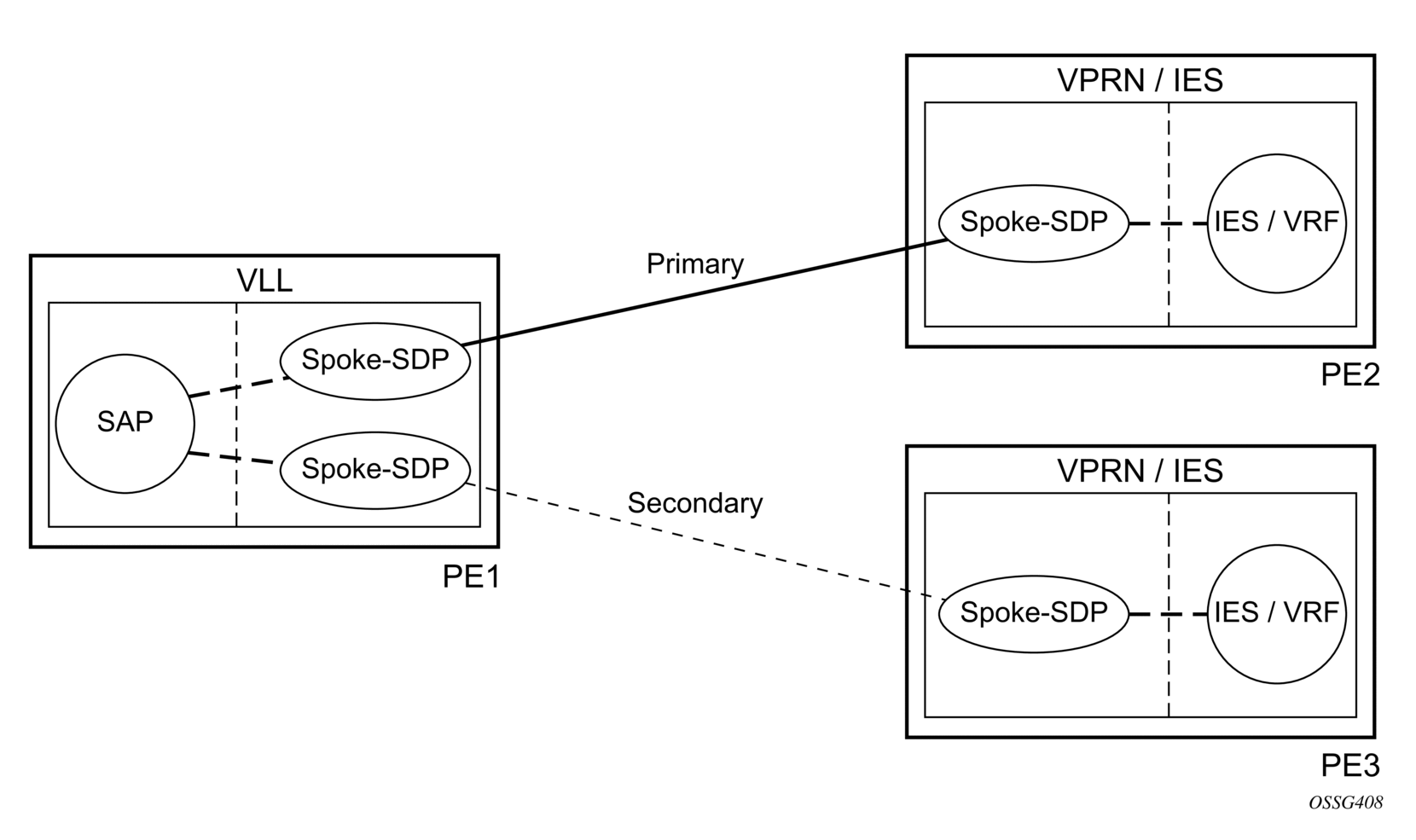
6.2.9. Using OSPF in IP-VPNs
| Note: OSPF as a PE-CE routing protocol is only supported for IPv4 VPNs. |
Using OSPF as a CE to PE routing protocol allows OSPF that is currently running as the IGP routing protocol to migrate to an IP-VPN backbone without changing the IGP routing protocol, introducing BGP as the CE-PE or relying on static routes for the distribution of routes into the service providers IP-VPN. The following features are supported:
- Advertisement/redistribution of BGP-VPN routes as summary (type 3) LSAs flooded to CE neighbors of the VPRN OSPF instance. This occurs if the OSPF route type (in the OSPF route type BGP extended community attribute carried with the VPN route) is not external (or NSSA) and the locally configured domain-id matches the domain-id carried in the OSPF domain ID BGP extended community attribute carried with the VPN route.
- OSPF sham links. A sham link is a logical PE-to-PE unnumbered point-to-point interface that essentially rides over the PE-to-PE transport tunnel. A sham link can be associated with any area and can therefore appear as an intra-area link to CE routers attached to different PEs in the VPN.
6.2.10. Service Label Mode of a VPRN
The 7210 SAS allocates one unique (platform-wide) service label per VRF. All VPN-IP routes exported by the PE from a particular VPRN service with that configuration have the same service label. When the PE receives a terminating MPLS packet, the service label value determines the VRF to which the packet belongs. A lookup of the IP packet DA in the forwarding table of the selected VRF determines the next-hop interface.
6.2.11. Multicast in IP-VPN Applications
Applications for this feature include enterprise customer implementing a VPRN solution for their WAN networking needs, customer applications including stock-ticker information, financial institutions for stock and other types of trading data and video delivery systems.
Figure 61 depicts an example of multicast in an IP-VPN application. The provider domain encompasses the core routers (1 through 4) and the edge routers (5 through 10). The various IP-VPN customers each have their own multicast domain, VPN-1 (CE routers 12, 13 and 16) and VPN-2 (CE Routers 11, 14, 15, 17 and 18). In this VPRN example, the VPN-1 data generated by the customer behind router 16 is multicast only by PE router 9 to PE routers 6 and 7 for delivery to CE routers 12 and 13 respectively. Data for VPN-2 generated by the customer behind router 15 is forwarded by PE router 8 to PE routers 5, 7 and 10 for delivery to CE routers 18, 11, 14 and 17 respectively.
Figure 61: Multicast in IP-VPN Applications
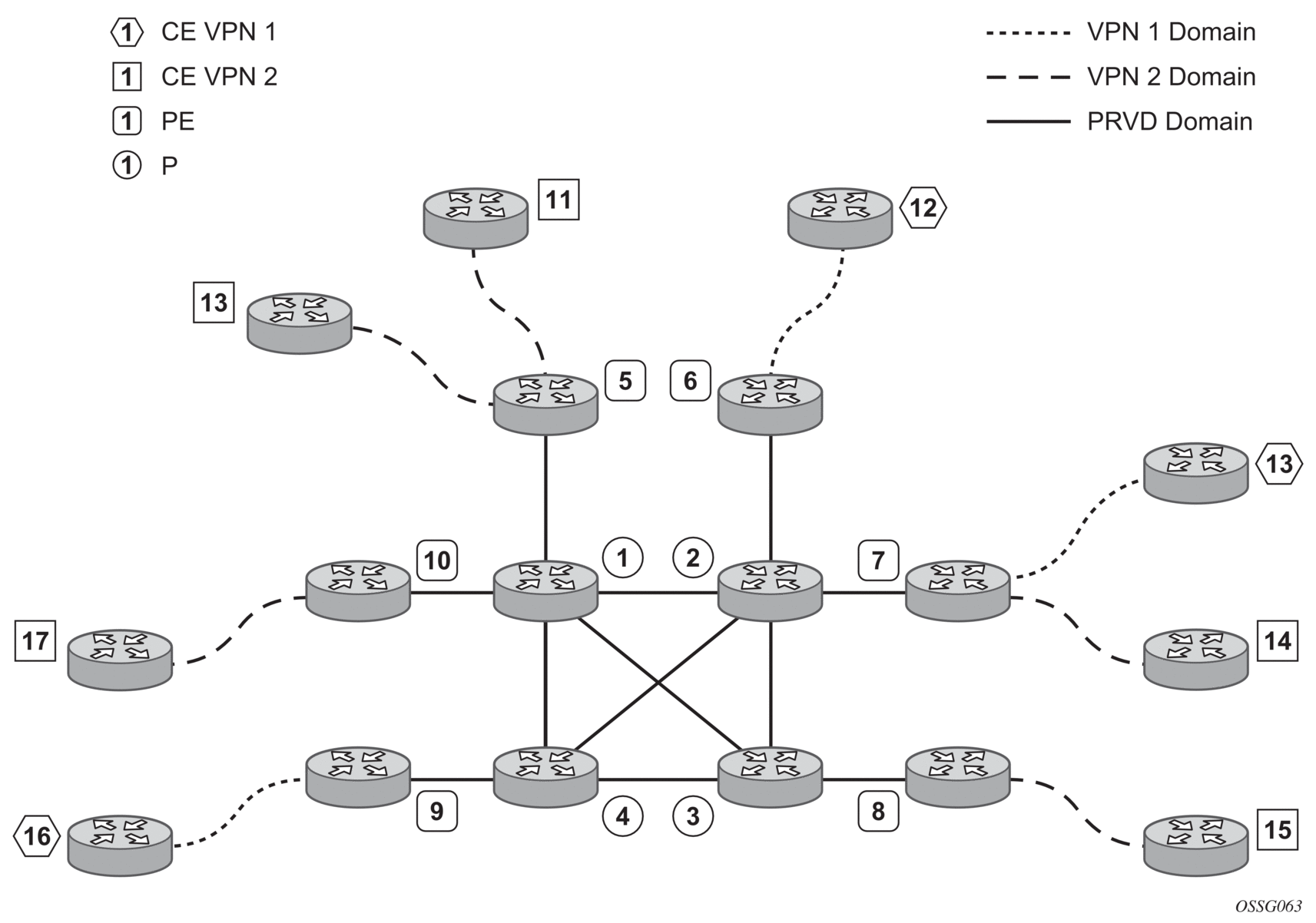
The demarcation of these domains is in the PE router (routers 5 through 10). The PE router participates in both the customer multicast domain and the provider multicast domain. The customer CE routers are limited to a multicast adjacency with the multicast instance on the PE created to support that specific customer IP-VPN. This way, customers are isolated from the provider core multicast domain and other customer multicast domains while the provider core routers only participate in the provider multicast domain and are isolated from all customer multicast domains.
The PE for a specific customer multicast domain becomes adjacent to the CE routers attached to that PE and to all other PE that participate in the IP-VPN (or customer) multicast domain. This is achieved by the PE, which encapsulates the customer multicast control data and multicast streams inside the provider multicast packets. These encapsulated packets are forwarded only to the PE nodes that are participating in the same MVPN domain and are part of the same customer VPRN. This prunes the distribution of the multicast control and data traffic to the PEs that do not participate in the customer multicast domain.
| Note: To enable ingress FC classification for packets received on a P2MP LSP on a network port IP interface and that needs to be replicated to IP receivers, use the loopback-no-svc-port>p2mpbud>p2mpbud-port-id>p2mp-bud-classification command. This command is required only on the 7210 SAS-R6 and 7210 SAS-R12 for ingress FC classification; for other platforms, this is not required.This command allows users to prioritize multicast traffic to IP receivers in the service. In addition, this command marks the packet with IP DSCP values while sending the multicast stream out of the IP interface. Before using the command, users must ensure that sufficient resources are available in the network ingress CAM resource pool and MPLS EXP ingress profile map resource pool. Use the tools>dump>system-resources command to check resource availability. |
6.2.11.1. Multicast Protocols Supported in the Provider Network
An MVPN is defined by two sets of sites: the sender sites set and receiver sites set, with the following properties.
- Hosts within the sender sites set could originate multicast traffic for receivers in the receiver sites set.
- Receivers not in the receiver sites set should not be able to receive this traffic.
- Hosts within the receiver sites set could receive multicast traffic originated by any host in the sender sites set.
- Hosts within the receiver sites set should not be able to receive multicast traffic originated by any host that is not in the sender sites set.
A site could be both in the sender sites set and receiver sites set, which implies that hosts within such a site could both originate and receive multicast traffic. An extreme case is when the sender sites set is the same as the receiver sites set, in which case all sites could originate and receive multicast traffic from each other.
Sites within a specific MVPN can only be within the same organizations, which implies that an MVPN can be an intranet. A given site may be in more than one MVPN, which implies that MVPNs may overlap. Not all sites of a given MVPN have to be connected to the same service provider, which implies that an MVPN can span multiple service providers.
Another way to look at MVPN is to say that an MVPN is defined by a set of administrative policies. These policies determine the sender sites set and receiver site set. These policies are established by MVPN customers, but implemented by MVPN service providers using the existing BGP/MPLS VPN mechanisms, such as route targets, with extensions, as necessary.
6.2.11.1.1. MVPN Using BGP Control Plane
The 7210 SAS supports next generation MVPN with MLDP and RSVP P2MP provider tunnels.
The Nokia implementation supports the following features.
- MVPN is supported all 7210 SAS platforms as described in this document.
- MVPN membership auto-discovery using BGP is supported.
- PE-PE transmission of C-multicast routing using BGP is supported.
- IPv4 is supported.
- Inter-AS MVPN with option A is supported. This does not require any additional control or data plane implementations.
6.2.11.1.2. MVPN Membership Auto-discovery using BGP
BGP-based auto-discovery (AD) is performed by using a multicast VPN address family. Any PE router that attaches to an MVPN must issue a BGP update message containing an NLRI in this address family, along with a specific set of attributes.
The PE router uses route targets to specify MVPN route import and export. The route target may be the same as the one used for the corresponding unicast VPN, or it may be different. The PE router can specify separate import route targets for sender sites and receiver sites for a given MVPN.
The route distinguisher (RD) that is used for the corresponding unicast VPN can also be used for the MVPN.
When BGP AD is enabled, PIM peering on the I-PMSI is disabled, so no PIM hellos are sent on the I-PMSI. C-tree to P-tunnel bindings are also discovered using BGP S-PMSI AD routes, instead of PIM join TLVs.
For example, if AD is disabled, the c-mcast-signaling bgp command fails and the following error message displays:
C-multicast signaling in BGP requires auto-discovery to be enabled
AD is enabled by default on the 7210 SAS-R6 and 7210 SAS-R12.
If c-mcast-signaling is set to bgp, the no auto-discovery command fails and the following error message displays:
C-multicast signaling in BGP requires auto-discovery to be enabled
When c-mcast-signaling is set to bgp, S-PMSI AD is always enabled (configuration is ignored).
6.2.11.2. Provider Tunnel Support
The following provider tunnels are supported:
- mLDP inclusive provider tunnel
- mLDP selective provider tunnel
- RSVP P2MP LSPs inclusive provider tunnel
- RSVP P2MP LSPs selective provider tunnel
6.2.12. Inter-AS VPRNs
Inter-AS IP-VPN services have been driven by the popularity of IP services and service provider expansion beyond the borders of a single Autonomous System (AS) or the requirement for IP VPN services to cross the AS boundaries of multiple providers. Three options for supporting inter-AS IP-VPNs are described in RFC 4364, BGP/MPLS IP Virtual Private Networks (VPNs).
NOTE: 7210 SAS platforms support only option-A and option-C. It does not support option-B. It described as follows only for the sake of completeness.
The first option, referred to as Option-A (Figure 62), is considered inherent in any implementation. This method uses a back-to-back connection between separate VPRN instances in each AS. As a result, each VPRN instance views the inter-AS connection as an external interface to a remote VPRN customer site. The back-to-back VRF connections between the ASBR nodes require individual sub-interfaces, one per VRF.
Figure 62: Inter-AS Option-A: VRF-to-VRF Model
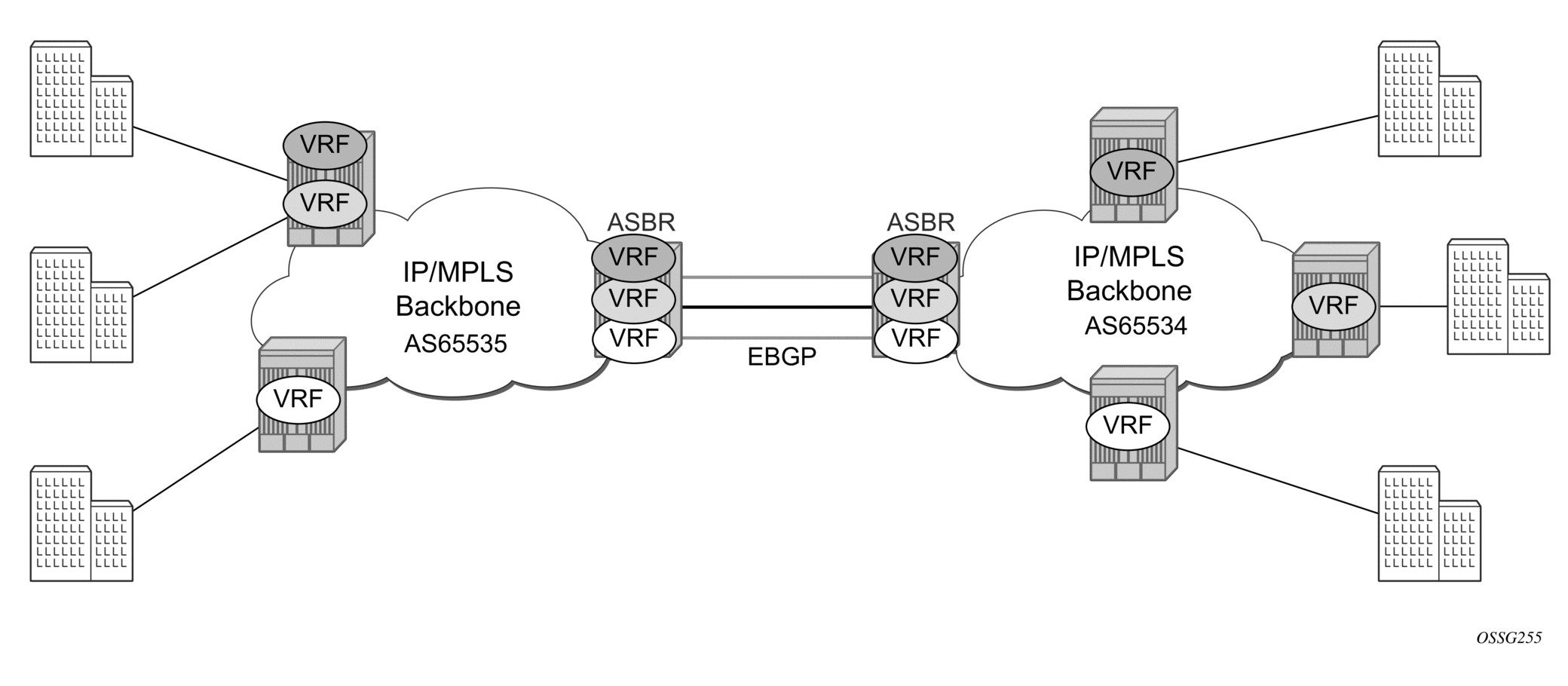
The second option, referred to as Option-B (Figure 63), relies heavily on the AS Boundary Routers (ASBRs) as the interface between the autonomous systems. This approach enhances the scalability of the eBGP VRF-to-VRF solution by eliminating the need for per-VPRN configuration on the ASBRs. However it requires that the ASBRs provide a control plan and forwarding plane connection between the autonomous systems. The ASBRs are connected to the PE nodes in its local autonomous system using iBGP either directly or through route reflectors.
This means the ASBRs receive all the VPRN information and will forward these VPRN updates, VPN-IPV4, to all its EBGP peers, ASBRs, using itself as the next-hop. It also changes the label associated with the route. This means the ASBRs must maintain an associate mapping of labels received and labels issued for those routes. The peer ASBRs will in turn forward those updates to all local IBGP peers.
Figure 63: Inter-AS Option-B

This form of inter-AS VPRNs does not require instances of the VPRN to be created on the ASBR, as in option-A, as a result there is less management overhead. This is also the most common form of Inter-AS VPRNs used between different service providers as all routes advertised between autonomous systems can be controlled by route policies on the ASBRs.
The third option, referred to as Option-C (Figure 64), allows for a higher scale of VPRNs across AS boundaries but also expands the trust model between ASNs. As a result this model is typically used within a single company that may have multiple ASNs for various reasons.
This model differs from Option-B, in that in Option-B all direct knowledge of the remote AS is contained and limited to the ASBR. As a result, in option-B the ASBR performs all necessary mapping functions and the PE routers do not need perform any additional functions then in a non-Inter-AS VPRN.
Figure 64: Option-C Example
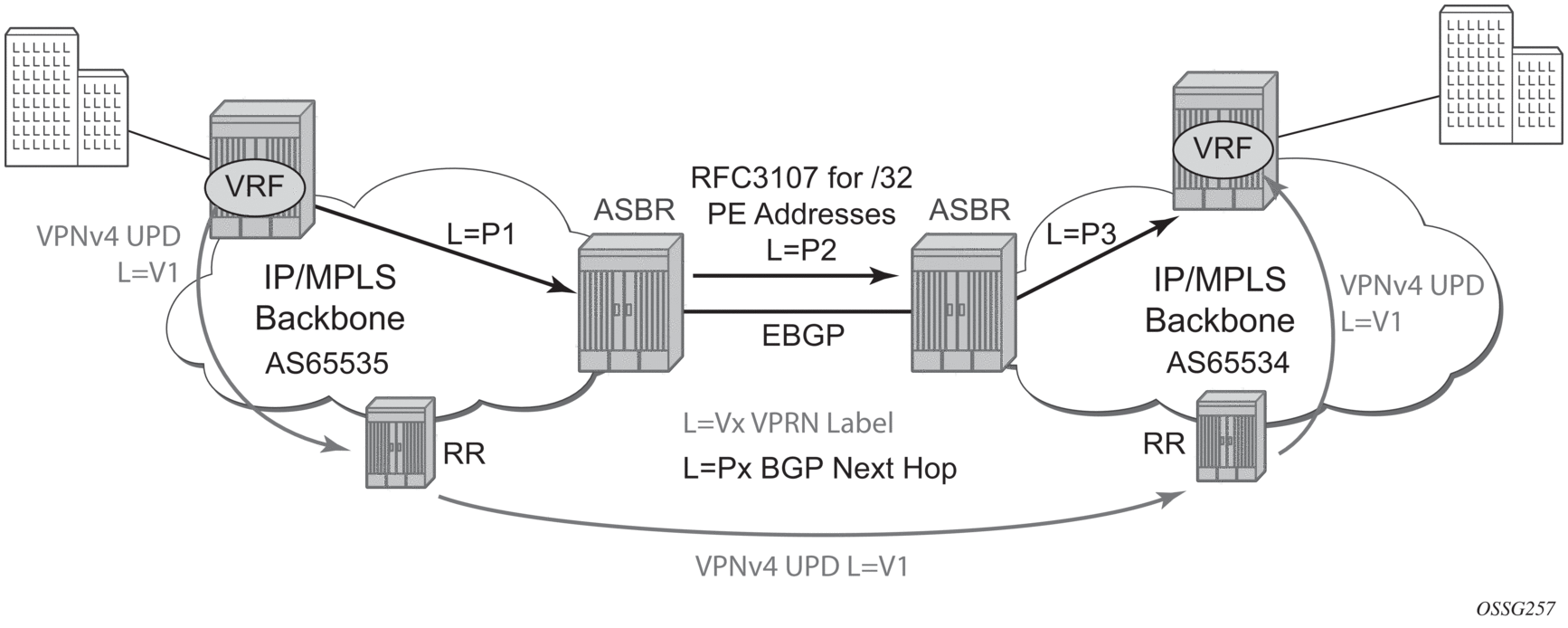
With Option-C, knowledge from the remote AS is distributed throughout the local AS. This distribution allows for higher scalability but also requires all PEs and ASBRs involved in the Inter-AS VPRNs to participate in the exchange of inter-AS routing information.
In Option-C, the ASBRs distribute reachability information for remote PE system IP addresses only. This is done between the ASBRs by exchanging MP-eBGP labeled routes, using RFC 3107, Carrying Label Information in BGP-4.
Distribution of VPRN routing information is handled by either direct MP-BGP peering between PEs in the different ASNs or more likely by one or more route reflectors in ASN.